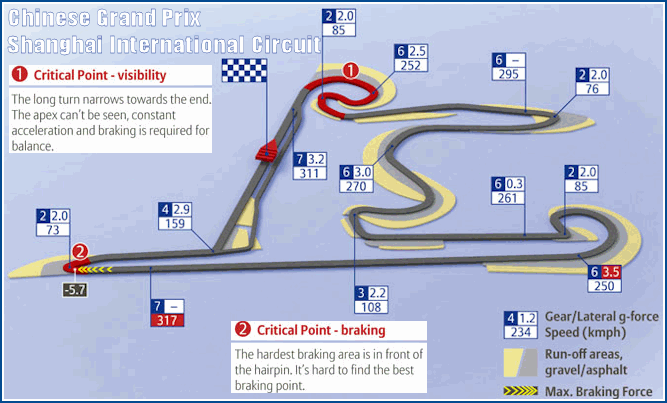2015 Chinese Grand Prix
The 2015 Chinese Grand Prix will be held 17-19 April. Friday is practice sessions, Saturday is practice and qualifying and the race takes place on Sunday. This is the fourth race on the 2015 F1 calendar. This article covers information about the circuit and what punters should consider when shopping the odds.
Shanghai International Circuit Information
 The Shanghai International Circuit is another brilliant design from famed F1 circuit architect Hermann Tilke. Shaped in the form of a Chinese character ‘shang’ (上) which translates to ‘high’, or ‘above’, the circuit is visually stunning.
The Shanghai International Circuit is another brilliant design from famed F1 circuit architect Hermann Tilke. Shaped in the form of a Chinese character ‘shang’ (上) which translates to ‘high’, or ‘above’, the circuit is visually stunning.
Turns 1-4 make up a backwards ‘S’ that is tight enough to make anyone upchuck their lunch. The G-forces coming out of the long straight after turn 16, leading into turn 1 must be phenomenal in a Formula 1 race car. Once the backwards ‘S’ is done, drivers are given a break up through a sharp turn 6, leading into some fun, sweeping turns that last until turn 10. A couple more turns, then the pedal drops to the floor.
Between turns 13 and the hairpin 14 is a long straight with a distance over a kilometer in length. Speeds over 320 kph are achieved before a brutal hairpin, then another long straight-away comes after turn 16.
Similar to the Sepang circuit, aside from a few very slow turns, this race is very fast. Top speeds can be achieved on two of the straights, and close to top speed on a third straight. Plenty of passing happens at the Chinese Grand Prix, and punters should look for value in the top 5 qualifying spots.
Location: Jiading District of Shanghai, China
Circuit: Shanghai International Circuit
Circuit Length: 5.451 km
Total Race Distance: 305.066 km
Turns: 16
Hard Turns: 8 (2, 3, 6, 9, 11, 12, 14, 16)
Hard Turns/Km: 1.4676
Fastest Lap Time: 1:32.238 (Schumacher, 2004)
Fastest Seconds/Km: 16.9213
Betting the 2015 Chinese Grand Prix
When betting after qualifying has ended, punters should look for value in any of the top 6 starting positions. Drivers from P1 – P6 tend to trade around their positions, so it’s a tougher race to predict than most others. In the past 6 races (2009-2014) the pollsitter has however happened to win three times. The 2010 race was a good example of the shifting that take place. The top finishers with (starting position noted as such were). 1st Jenson Button (P5), 2nd Lewis Hamilton (P6), 3rd Nico Rosberg (P4), 4th Fernando Alonso (P3), 5th Robert Kubica (P8), 6th Sebastian Vettel (P1), 7th Vitaly Petrov (P14), and 8th Mark Webber (P2).
In 2013 Fernando Alonso won and in 2011 Lewis Hamilton won both which started P3. In 2012 Lewis Hamilton started P7 but finished second, and in 2011 Mark Webber came from P18 to finish on the podium. So again there is plenty of movement to make looking deeper when betting F1 race winner for the China event. If you happen to bet the 2015 Chinese Grand Prix before practice and qualifying, this is an opportunity to look for big odds. At the Chinese Grand Prix, picking a favoured driver with low odds is usually a poor choice as far as expected value is concerned.
For profitable Top 3 bets, I prefer to select a driver starting in P6 or earlier. Despite it happening in 2012 and 2011 it is uncommon for P7+ drivers to finish on the podium. It is however quite common to see P4 – P6 drivers finish on the podium. Thus, I prefer to look for a single driver in this area who I have a lot of confidence in. If I can get 2/1 or better on a P4 – P6 driver I believe in, I’m usually dropping a bet here.
For top 6 Bets, in most years, the Chinese Grand Prix will have one or two drivers starting in P7 or lower that finish in the top 6. The trick is figuring out which one or two drivers that will be. Instead of going after someone lower than P6, I generally wait until qualifying is done, then look at the 2 or 3 drivers with the greatest odds within the top 6. I’m usually going to bet on the guy who I have the most confidence in, as long as the odds aren’t too low. A driver like this will generally make the top 6, and offer me better odds than the 3 biggest favorites. I usually want to get 2/3 – 10/11 depending on his starting position.
Further Research
Wikipedia Entry: Chinese Grand Prix is the hub to visit when wanting to really get a strong idea of past results. The lower table that list winners has links labelled reports. By clicking those links you will find very detailed reports for each year. The table that shows race results includes each driver’s starting position. You can also find the cause and lap for any drivers that retired early. From here you can skim the reports above all that, to gain a better understanding of what happened in that particular race. Spending some time researching can help greatly in coming up with your own predictions for the 2015 Chinese Grand Prix. Again Wikipedia is a very valuable resource for F1 betting in general.
Circuit Dynamics

